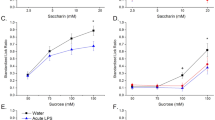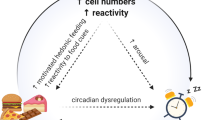Abstract
Binge-eating behavior involves rapid consumption of highly palatable foods leading to increased weight gain. Feeding in binge disorders resembles other compulsive behaviors, many of which are responsive to N-acetylcysteine (NAC), which is a cysteine prodrug often used to promote non-vesicular glutamate release by a cystine–glutamate antiporter. To examine the potential for NAC to alter a form of compulsive eating, we examined the impact of NAC on binge eating in a rodent model. Specifically, we monitored consumption of standard chow and a high-fat, high carbohydrate western diet (WD) in a rodent limited-access binge paradigm. Before each session, rats received either a systemic or intraventricular injection of NAC. Both systemic and central administration of NAC resulted in significant reductions of binge eating the WD without decreasing standard chow consumption. The reduction in WD was not attributable to general malaise as NAC did not produce condition taste aversion. These results are consistent with the clinical evidence of NAC to reduce or reverse compulsive behaviors, such as, drug addiction, skin picking and hair pulling.
This is a preview of subscription content, access via your institution
Access options
Subscribe to this journal
Receive 12 print issues and online access
$259.00 per year
only $21.58 per issue
Buy this article
- Purchase on Springer Link
- Instant access to full article PDF
Prices may be subject to local taxes which are calculated during checkout


Similar content being viewed by others
References
OECD . OECD Health Data: Non-Medical Determinants of Health. OECD Health Statistics OECD Publishing: Paris, 2013.
Hudson JI, Hiripi E, Pope HG, Kessler RC . The prevalence and correlates of eating disorders in the National Comorbidity Survey Replication. Biol Psychiatry 2007; 61: 348–358.
American Psychiatric Association. Diagnostic and Statistical Manual of Mental Disorders: DSM-5. American Psychiatric Association publishing: Arlington, VA, USA, 2013.
Gearhardt AN, White MA, Potenza MN . Binge eating disorder and food addiction. Current Drug Abuse Rev 2011; 4: 201–207.
Johnson PM, Kenny PJ . Dopamine D2 receptors in addiction-like reward dysfunction and compulsive eating in obese rats. Nat Neurosci 2010; 13: 635–641.
Fisher JO, Birch LL . Eating in the absence of hunger and overweight in girls from 5 to 7 y of age. Am J Clin Nutr 2002; 76: 226–231.
Marcus MD, Kalarchian MA . Binge eating in children and adolescents. Int J Eat Disord 2003; 34: S47–S57.
Kalivas PW, LaLumiere RT, Knackstedt L, Shen H . Glutamate transmission in addiction. Neuropharmacology 2009; 56: 169–173.
Amen SL, Piacentine LB, Ahmad ME, Li SJ, Mantsch JR, Risinger RC et al. Repeated N-acetyl cysteine reduces cocaine seeking in rodents and craving in cocaine-dependent humans. Neuropsychopharmacology 2011; 36: 871–878.
Grant JE, Odlaug BL, Kim SW . N-acetylcysteine a glutamate modulator, in the treatment of trichotillomania: a double-blind, placebo-controlled study. Arch Gen Psychiatry 2009; 66: 756–763.
McClure EA, Gipson CD, Malcolm RJ, Kalivas PW, Gray KM . Potential role of N-acetylcysteine in the management of substance use disorders. CNS Drugs 2014; 28: 95–106.
Bridges R, Lutgen V, Lobner D, Baker DA . Thinking outside the cleft to understand synaptic activity: contribution of the cystine-glutamate antiporter (System xc-) to normal and pathological glutamatergic signaling. Pharmacol Rev 2012; 64: 780–802.
Lin P, Pratt WE . Inactivation of the nucleus accumbens core or medial shell attenuates reinstatement of sugar-seeking behavior following sugar priming or exposure to food-associated cues. PLoS One 2014; 9: e99301.
Baker DA, McFarland K, Lake RW, Shen H, Tang XC, Toda S et al. Neuroadaptations in cystine-glutamate exchange underlie cocaine relapse. Nat Neurosci 2003; 6: 743–749.
Corwin RL, Wojnicki FHE, Fisher JO, Dimitriou SG, Rice HB, Young MA . Limited access to a dietary fat option affects ingestive behavior but not body composition in male rats. Physiol Behav 1998; 65: 545–553.
Paxinos G, Watson C . The Rat Brain in Stereotaxic Coordinates. Academic Press: New York, NY, USA, 2007.
Kupchik YM, Moussawi K, Tang X-C, Wang X, Kalivas BC, Kolokithas R et al. The effect of N-acetylcysteine in the nucleus accumbens on neurotransmission and relapse to cocaine. Biological Psychiatry 2012; 71: 978–986.
Baker DA, Xi ZX, Shen H, Swanson CJ, Kalivas PW . The origin and neuronal function of in vivo nonsynaptic glutamate. J Neurosci 2002; 22: 9134–9141.
Kalivas PW, Lalumiere RT, Knackstedt L, Shen H . Glutamate transmission in addiction. Neuropharmacology 2009; 1: 169–173.
Baker DA, McFarland K, Lake RW, Shen H, Tang X-C, Toda S et al. Neuroadaptations in cystine-glutamate exchange underlie cocaine relapse. Nat Neurosci 2003; 6: 743–749.
Knackstedt LA, LaRowe S, Mardikian P, Malcolm R, Upadhyaya H, Hedden S et al. The role of cystine-glutamate exchange in nicotine dependence in rats and humans. Biol Psychiatry 2009; 65: 841–845.
Odlaug BL, Grant JE . N-acetyl cysteine in the treatment of grooming disorders. J Clin Psychopharmacol 2007; 27: 227–229.
Acknowledgements
This work was supported by the US National Institute of Diabetes and Digestive and Kidney Diseases (NIDDK; DK074734) and the US National Institute on Drug Abuse (NIDA: DA035088).
Author information
Authors and Affiliations
Corresponding author
Ethics declarations
Competing interests
The authors declare no conflict of interest.
Rights and permissions
About this article
Cite this article
Hurley, M., Resch, J., Maunze, B. et al. N-acetylcysteine decreases binge eating in a rodent model. Int J Obes 40, 1183–1186 (2016). https://doi.org/10.1038/ijo.2016.31
Received:
Revised:
Accepted:
Published:
Issue Date:
DOI: https://doi.org/10.1038/ijo.2016.31
This article is cited by
-
The Potential of N-acetyl Cysteine in Behavioral Addictions and Related Compulsive and Impulsive Behaviors and Disorders: a Scoping Review
Current Addiction Reports (2022)
-
A combination of an antioxidant with a prebiotic exerts greater efficacy than either as a monotherapy on cognitive improvement in castrated-obese male rats
Metabolic Brain Disease (2020)
-
A narrative review of potential treatment strategies for food addiction
Eating and Weight Disorders - Studies on Anorexia, Bulimia and Obesity (2017)



